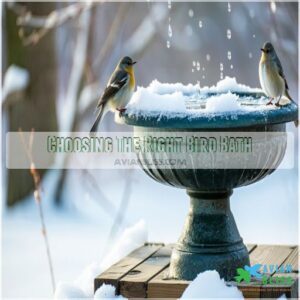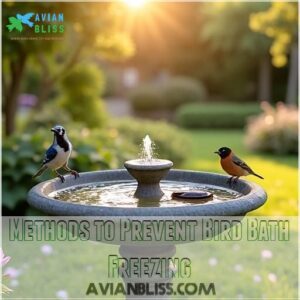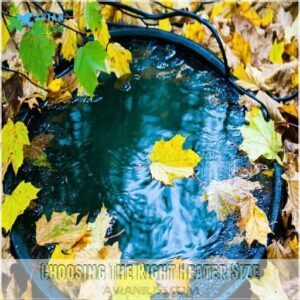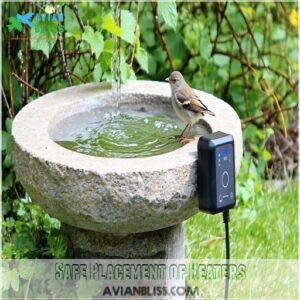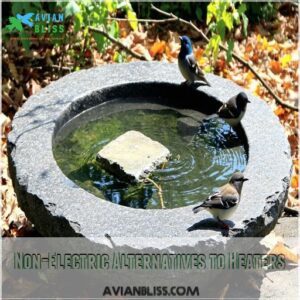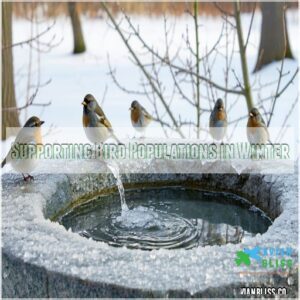This site is supported by our readers. We may earn a commission, at no cost to you, if you purchase through links.
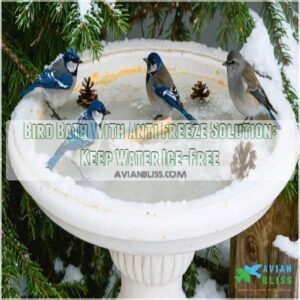
Instead, try safer options like adding a floating object or using an electrical de-icer to keep the water ice-free. You can even use solar-powered fountains for a splash of nature’s own magic. These methods keep the birds happy and hydrated without any risk.
Wondering about other smart ways to tackle freezing? There’s more to explore!
Table Of Contents
- Key Takeaways
- Choosing The Right Bird Bath
- Bird Bath Location for Winter
- Methods to Prevent Bird Bath Freezing
- Bird Bath Heater Methods
- Non-Electric Alternatives to Heaters
- Preventing Freezing With Movement
- Maintaining Your Bird Bath
- Supporting Bird Populations in Winter
- Common Mistakes to Avoid
- Winter Bird Bath Maintenance Tips
- Frequently Asked Questions (FAQs)
- How to keep a bird bath from freezing?
- Can you put anti-freeze in a bird bath?
- Can a hollow ball prevent a bird bath from freezing?
- What is a heated bird bath?
- What happens if bird bath water freezes?
- How do you keep a bird bath ice-free?
- What can I put in my bird bath to keep it from freezing?
- What is the best sealer for a bird bath?
- Do copper pennies keep bird baths clean?
- How do you give birds water in freezing weather?
- Is antifreeze toxic to birds?
- What type of antifreeze is bird-safe?
- How much antifreeze should I use?
- Will antifreeze attract predators?
- Does antifreeze affect water quality?
- Conclusion
Key Takeaways
- Don’t use antifreeze, salt, or sugar in your bird bath because these substances are toxic to birds and can harm their feathers.
- Opt for safer methods, like using a floating object or an electrical de-icer, to keep the water from freezing and ensure bird safety.
- Position your bird bath in a sunny, sheltered spot to naturally reduce freezing and avoid placing it in shaded or windy areas.
- Regularly inspect and maintain your bird bath, using clean water and checking for ice, to prevent contamination and support wildlife through winter.
Choosing The Right Bird Bath
When choosing a bird bath for winter, make sure it’s tough enough to handle the cold.
Pick materials like metal or plastic.
Avoid anything fragile, like ceramic or glass, unless you want to create a penguin ice rink!
Durable Materials for Winter Use
When winter rolls around, go for metal, plastic, or resin bird baths.
These durable materials will stand strong against freezing temperatures.
Imagine giving your feathered friends a cozy spa, minus the ice!
Metal bird baths handle the chill with ease, while plastic and resin remain steadfast.
Keep water ice-free, making it a safe landing for birds craving a winter oasis.
Avoiding Delicate Materials
Choosing materials for your bird bath? Steer clear of delicate ones like porcelain and glass.
They’re like the fancy shoes you can’t wear in the snow—pretty but impractical.
Winter damage can lead to toxic bird bath trouble if cracks leak harmful substances.
Opt for durable choices to avoid freezing risks and make sure your feathered friends are safe.
Considering a Separate Bird Bath
Opting for a separate bird bath for winter might sound like overkill, but it makes sense when considering bird bath safety, especially with features like anti-slip surfaces bird bath with anti slip surface.
You can compare costs and space requirements while setting up an easy cleaning routine.
This choice prevents bird bath poisoning from DIY antifreeze alternatives.
Consider aesthetics and storage options to fit your space, keeping your feathered friends safe and happy.
Bird Bath Location for Winter
When you’re choosing a spot for your bird bath this winter, find a sunny, sheltered location where the water can soak up sunlight and escape the worst of the wind.
If you can put it near a patio heater or fire pit for a splash of extra warmth, even better—birds will think they’ve stumbled upon the tropics!
Sunny Areas for Reduced Freezing
Position your bird bath strategically to harness the sun’s power! Sunlight exposure is key to preventing a frozen bird bath.
Here’s how to maximize winter sun angles:
- Find the sunniest spot in your yard.
- Observe the sun’s path throughout the day.
- Place the bird bath where it gets the most direct sunlight.
- Remember, a sunny spot means less freezing.
This simple bird bath placement trick can make a big difference. You’ll help our feathered friends stay hydrated all winter long!
Sheltered Areas for Protection
Nestled under tree cover or near landscape features, a bird bath can shine even in winter.
Natural barriers and overhangs act like cozy blankets, shielding it from harsh winds.
Keep it safe by avoiding antifreeze solutions that could harm birds.
Instead, use windbreaks to create sheltered areas.
Remember, nothing’s more comforting than a snug, secure spot for feathered friends.
| Windbreaks | Natural Barriers | Bird Bath Safety |
|---|---|---|
| Trees | Overhangs | Avoid Antifreeze |
| Shrubs | Walls | Safe Solutions |
| Fences | Rocks | Poisoning Risks |
Heated Areas for Prevention
Considering shelter, placing your bird bath near a heated space like a patio heater or fire pit can prevent freezing.
Make sure it’s far enough to avoid overheating—a toasty bath isn’t the goal here.
Be vigilant about safety to dodge heated bird bath dangers, like antifreeze poisoning or contamination.
Remember, it’s all about keeping feathered friends cozy and water ice-free!
Methods to Prevent Bird Bath Freezing
To keep your bird bath ice-free this winter, try placing a floating object in the water or set it up in a bright spot with lots of sun.
Electrical de-icers or solar-powered aerators can also be used to keep things moving and birds happy.
Using a Floating Object
Ever wondered how to keep your bird bath ice-free without any fuss?
Tossing in a floating object might do the trick!
Floating objects like wine corks or rubber balls create gentle movement, reducing freezing risks.
Opt for bird-safe methods like DIY cork floats to avoid bird bath poisoning.
A quirky little solution, but hey, it keeps your feathered pals happy!
Positioning in a Bright Location
Place your bird bath where it can catch some rays.
Sunlight exposure is the key to keeping water from freezing over.
Think of it as your bird bath’s cozy winter blanket.
Proper bird bath placement, considering the winter sun path, helps avoid bird bath hazards like contamination.
Just make sure it’s not in a spot that’s too shady or drafty!
Electrical De-icers for Prevention
Plugging in an electrical de-icer is like giving your bird bath a cozy electric blanket. These gadgets keep water above freezing, letting your feathered friends enjoy a splash even in the coldest months.
- Safety precautions: Make sure it’s rated for outdoor use.
- Installation tips: Follow the manual.
- Types of de-icers: Floating vs. submerged.
- De-icer maintenance: Check for cracks.
- Cost comparison: Weigh initial investment against winter benefits.
Solar-Powered Aerators for Movement
Combat freezing with solar-powered aerators!
These nifty devices gently churn the water, preventing ice buildup.
It’s like a tiny, eco-friendly fountain for your feathered friends.
They’re a fantastic addition to your winter bird care routine, ensuring a constant supply of fresh water.
No more frozen bird baths!
Consider adding solar-powered aerators to your bird bath maintenance plan.
This simple solution offers peace of mind, knowing your birds always have access to fresh, unfrozen water.
Bird Bath Heater Methods
When you’re trying to keep your bird bath ice-free in winter, using a heater can be a real lifesaver.
Just make sure to pick the right size, place it safely, and check it often for damage—your feathered friends will thank you!
Choosing The Right Heater Size
Picking the right heater size for your bird bath is like finding the perfect pair of shoes. Consider these points:
- Bird bath size: Know the water volume your bath holds.
- Heater wattage: Match the wattage to the water volume for efficiency.
- Energy efficiency: Choose models that conserve power.
- Safety concerns: Make sure the heater suits outdoor use.
You’re making a cozy haven for winter birds!
Safe Placement of Heaters
Keep your feathered friends safe by wisely placing your bird bath heater.
Avoid a fire risk by routing cords safely and securing them away from water sources.
Choose a spot to optimize heater size and efficiency without causing bird bath contamination.
Humorously said, like a pet cat, make sure it bathes comfortably.
Balance warmth, access, and safety like a juggling act.
| Tip | Description |
|---|---|
| Cord Routing | Keep all cords dry and away from water |
| Heater Size | Match heater to bird bath dimensions |
| Fire Prevention | Secure heater to avoid tipping |
| Water Contamination | Prevent contact to minimize risk |
Regular Inspection for Damage
Imagine your bird bath as a trusty winter coat—it needs a thorough check-up to stay in good shape!
Regularly inspect your bird bath heater for cracks or corrosion signs.
Look for any winter wear and tear that might lead to frozen damage.
This way, you avoid bird bath contamination that could risk antifreeze poisoning birds.
Stay safe and vigilant!
Non-Electric Alternatives to Heaters
Don’t let freezing weather turn your bird bath into a bird skating rink; there are simple non-electric tricks to keep it liquid.
Insulating the bottom with sand,
using dark containers to soak up sun,
or even plopping in heated stones to keep that ice at bay.
Insulating The Bird Bath Bottom
When battling icy bird baths, think of insulating the bottom like tucking them into a cozy blanket.
For a more convenient solution, you can also explore store-bought bird bath insulation.
Here’s how to winterize with a touch of DIY finesse:
- Use gravel or sand to create insulation.
- Try rubber mats under the bath.
- Opt for foam panels beneath the base.
- DIY insulation wraps with cozy fabrics.
These tricks keep water flowing!
Regular Water Changes
Switching gears from insulation, let’s talk about regular water changes.
Fresh water is key for bird safety, especially during winter.
Dirty water can spread disease, and freezing water is, well, frozen!
Consider implementing an automatic bird bath refill system to guarantee a consistent water supply.
How often should you change the water?
| Water Change Frequency | Water Quality | Water Temperature |
|---|---|---|
| Daily in freezing temps | Clean, clear | Above freezing |
| Every other day, mild temps | Check daily | Above freezing |
| Every 3 days, warm days | May need cleaning | Above freezing |
Remember, consistent water changes guarantee your feathered friends stay happy and healthy.
Clean water equals healthy birds!
Using Dark-Colored Containers
Want an easy way to keep your bird bath ice-free?
Dark-colored containers absorb more heat from sunlight.
This simple hack helps maintain water temperature, slowing freezing in winter months.
The impact of sunlight on darker surfaces is like having an undercover heater.
Just be careful; antifreeze solutions aren’t safe for birds.
Embrace nature’s warming touch, not bird bath poisoning!
Heating Stones or Concrete Blocks
Dark-colored containers give your bird bath a head start, but heating stones or concrete blocks takes it to the next level.
Toss them into a fire pit or a stove, then place them in the bath.
They act like little heaters, slowly releasing warmth.
Just remember, rock safety matters—don’t cook them too long or they might crack!
Preventing Freezing With Movement
Keeping your bird bath from freezing in winter doesn’t have to be a chore when you use movement.
Solar bird bath fountains or water agitators can do the trick, adding a bit of splash to keep things flowing even in cold weather.
Solar Bird Bath Fountains
Looking for a smart way to keep your bird bath ice-free without plugging it in?
Solar bird bath fountains are your go-to!
These nifty gadgets use the sun’s rays to power their gentle water movement, keeping things from freezing solid.
By incorporating solar-powered bird baths, you can also attract more birds with moving water features.
They’re energy-efficient and easy to set up, but they also offer a charming touch to your backyard.
Remember to keep your solar fountain clean and make sure it’s exposed to plenty of sunlight for the best effect.
It’s a win-win: happy birds and a nifty eco-friendly solution for your sanctuary!
Bird Bath Water Agitators
When you’re keen to keep your bird bath from freezing, bird bath water agitators can be your best friend.
Agitators add movement to the water, making it harder for ice to form.
They’re a low-maintenance choice, and here’s why:
- Variety: Options range from electric agitators to simple DIY types.
- Reliability: They effectively maintain open water, promoting bird visits.
- Placement: Ensure proper immersion for maximum impact.
So, embrace the science—by keeping your bird bath in motion, you’re preventing ice but also creating a lively backyard, no magic potions needed!
Maintaining Your Bird Bath
To keep your bird bath functional and inviting, make it a habit to empty it before nightfall to protect it from freezing.
Replace any floating objects regularly; this simple step can prevent a layer of ice from forming, ensuring your feathered friends have fresh water even on the chilliest days.
Emptying Before Nightfall
To prevent nighttime freezing, empty your bird bath before temperatures plummet. This simple act safeguards feathered friends from icy traps. Remember, water expands when freezing, potentially cracking your bird bath!
Here’s a handy guide:
| Time of Day | Action | Reason |
|---|---|---|
| Early Evening | Empty the bird bath | Prevents overnight freezing and cracking |
| Before Sunset | Thoroughly clean the bath | Removes debris and prevents bacterial growth |
| Morning | Refill with fresh, warm water | Provides birds with readily available water |
This routine minimizes the risk of bird bath poisoning from antifreeze solutions and guarantees bird safety. Plus, it’s a small act with big rewards for your winter wildlife visitors!
Replacing Floating Devices
You’ve made it through emptying the bird bath; now let’s chat about keeping those floating devices in check.
They’re like tiny lifeguards, bobbing around to prevent that dreaded ice-up.
Additionally, consider incorporating a solar-powered heater as a supplement to your floating devices for extra warmth.
Change them every few days to stay ahead of winter.
The types of floating devices range from store-bought gadgets to DIY creations like tennis balls or corks.
Make sure they’re effective by replacing them frequently.
Want alternatives? Try warming pebbles instead.
But remember—never use antifreeze. It’s a bird bath, not a cocktail, and antifreeze is dangerous for our feathered friends.
Keep it safe and cozy for all your wildlife visitors!
Supporting Bird Populations in Winter
When winter rolls around, you can become a bird’s best friend by keeping your bird bath ice-free and providing a reliable water source.
Giving birds food and water helps them thrive, like inviting neighbors over for hot cocoa on a snowy day, supporting biodiversity and healthy ecosystems.
Providing Food and Water
Even though winter’s chill seems to whisper "stay inside," offering food and water to birds is a lifesaver.
Opt for types of bird feeders that suit winter diets, like those easy DIY feeders.
Be cautious—ensure bird food safety to prevent any bird bath antifreeze dangers.
Fresh water sources are essential, minus any antifreeze which could be bird bath poison.
Mitigating Habitat Loss and Degradation
Winter can be tough for birds, especially when their habitats are disappearing faster than your breath in the cold air. Helping them out isn’t just about tossing seeds; it’s about creating spaces too. Providing a bird bath with an anti freeze bird bath solution is a great addition to these spaces.
- Plant native species to restore habitats.
- Opt for sustainable landscaping.
- Develop urban green spaces.
- Build wildlife corridors and pollinator gardens.
Every little bit helps them thrive!
Importance of Biodiversity and Ecosystem Health
A healthy ecosystem is like a bustling city, each species—big and small—playing a role.
Birds are essential in this urban jungle, controlling pests, pollinating plants, and spreading seeds.
Protected habitats and thoughtful actions like bird-safe methods help guarantee their survival.
Winter bird baths with antifreeze solutions boost biodiversity benefits and ecosystem services, supporting wildlife conservation against climate change impacts.
| Threat | Impact |
|---|---|
| Habitat Loss | Species Depletion |
| Climate Change | Resource Scarcity |
| Pollution | Health Hazards |
| Invasive Species | Ecosystem Disruption |
Common Mistakes to Avoid
When trying to keep your bird bath ice-free this winter, it’s easy to slip up if you’re not careful.
Avoid common pitfalls like using chemicals or salt, which might harm our feathered friends.
And ditch the idea of removing the bird bath completely—it’s like shutting down the bird spa just when demand peaks!
Using Chemicals in The Bird Bath
Helping birds through winter means providing clean water, but never use chemicals in your bird bath.
Bird bath chemicals, like antifreeze, are incredibly toxic.
Even a tiny amount can be deadly to birds.
Instead of risking bird bath antifreeze death, opt for safer methods like a heater or regular water changes.
Protecting birds is simple with a little care; avoid bird bath antifreeze risks completely.
Remember, a healthy bird is a happy bird!
Removing The Bird Bath in Winter
Taking away your bird bath in winter seems smart, but it’s a cold comfort to thirsty birds.
Keep it out with antifreeze dangers in mind, offering a safe sip instead.
Consider:
- Winter storage—wrong move!
- Freezing temperatures—not a shutdown sign.
- Cleaning tips—winter-ready maintenance.
- Alternative water sources—creative solutions.
Ensure bird safety without resorting to bird bath antifreeze hazards.
Using Salt to Stop Freezing
While salt can melt ice on your driveway, it’s a no-go for bird baths.
It poses a risk of salt toxicity and harms bird health, leading to unintended consequences.
Instead, try bird-friendly deicers.
They’re the safer bet for your feathered friends.
Let’s break it down:
| Unsafe with Salt | Safer Alternatives |
|---|---|
| Salt Toxicity | Bird-Friendly Deicers |
| Health Risks | Natural Alternatives |
Winter Bird Bath Maintenance Tips
Keeping your bird bath ice-free in winter is important for our feathered friends and easier than you might think.
A little upkeep, like defrosting and cleaning, makes sure it stays safe and inviting—plus, even birds prefer their drinks without ice cubes!
Defrosting a Frozen Bird Bath
You’ve avoided mistakes, now let’s tackle that stubborn frozen bird bath. Picture it: the bird bath’s turned into an icy trap, not the winter wonderland you imagined.
First, pour warm (not boiling) water to gently thaw the ice. This way, you won’t crack the basin. Consider placing a plastic garden spade under the ice to lift it out.
For a more long-term solution, consider investing in a bird bath heater. To prevent refreezing, use a floating ball for gentle water movement.
Remember, adding antifreeze is a no-go—it harms our feathered friends. Keep it natural, and your bird bath will be a winter oasis.
Keeping The Bird Bath Clean and Safe
With winter’s chill gripping tightly, keeping your bird bath clean and safe becomes critical.
Think of it like giving your feathered friends a spa day.
Regular cleaning maintains water quality and bird safety, preventing nasty buildup.
Use gentle cleaning supplies—a splash of vinegar does wonders.
To keep the water cool and attract more birds, consider placing the bird bath in a shady spot.
Stick to a regular cleaning frequency to make sure it’s sparkling for visitors.
Remember, never use antifreeze; it’s harmful to birds.
Instead, focus on practical bird bath antifreeze prevention methods like positioning for sunlight and using safe heaters.
Keep everything spotless, and your winter bird bath will be an oasis for our avian buddies.
Frequently Asked Questions (FAQs)
How to keep a bird bath from freezing?
To keep your bird bath from freezing, place it in the sun, use a floating object like a rubber ball, and consider an electrical de-icer or solar fountain.
These help maintain water movement, preventing ice formation.
Can you put anti-freeze in a bird bath?
Putting anti-freeze in a bird bath to prevent freezing is like tossing a life preserver made of lead—sounds efficient but terribly dangerous.
Anti-freeze chemicals are toxic to birds and other wildlife.
Opt for safer, natural methods instead.
Can a hollow ball prevent a bird bath from freezing?
A hollow ball can help prevent a bird bath from freezing.
It creates movement in the water, slowing ice formation.
Much like giving your coffee a quick stir to keep it from getting too cold.
What is a heated bird bath?
A heated bird bath is like a warm oasis in the chill of winter, keeping the water from freezing through an electric heating element.
It guarantees birds always have access to fresh water despite cold temperatures.
What happens if bird bath water freezes?
If your bird bath freezes, birds lose a key water source and could slip on the icy surface.
Frozen water might damage the bath too, leading to cracks.
Keep it thawed to maintain their winter oasis.
How do you keep a bird bath ice-free?
Keeping a bird bath ice-free is like playing tug-of-war with winter.
Use a small heater or a floating object to keep water moving, and place your bird bath in a sunny spot to prevent freezing.
What can I put in my bird bath to keep it from freezing?
Don’t let frozen bird baths leave feathered friends thirsty!
Try a bird bath heater, or add a floating ball to keep the water moving.
Sunlight helps too; place it where the sun shines.
Regularly check and clear ice.
What is the best sealer for a bird bath?
Sealing a bird bath is really important, like putting a cherry on top of your water feature sundae.
Sealing is important to keep your basin leak-free and bird-safe.
Use a non-toxic, waterproof sealer, like silicone or a concrete/masonry sealer.
Do copper pennies keep bird baths clean?
Copper pennies won’t magically keep bird baths clean, but they might slightly inhibit algae growth due to copper’s natural properties.
Regular cleaning is still your best bet, though.
How do you give birds water in freezing weather?
Warm water works wonders!
Try topping up bird baths with warm water in the morning.
Use bird bath heaters for consistent warmth or float a rubber ball to prevent ice.
Keep it safe, and your feathered friends will flourish!
Is antifreeze toxic to birds?
Antifreeze can be extremely toxic to birds.
Even small amounts can be harmful or fatal.
Instead of using antifreeze, consider safer methods like bird bath heaters or solar-powered solutions to prevent water from freezing in winter.
What type of antifreeze is bird-safe?
Avoid using antifreeze in bird baths, even propylene glycol which is less toxic than ethylene glycol, because any amount can still harm birds.
Instead, opt for bird bath heaters or solar options to keep the water from freezing.
How much antifreeze should I use?
Don’t use antifreeze in bird baths—it’s toxic to birds.
Instead, focus on safe methods like a bird bath heater, or floating a small ball to keep water moving.
Prioritize bird safety over convenience during colder months.
Will antifreeze attract predators?
Imagine a curious cat, drawn by the sweet scent of antifreeze!
Using antifreeze in your bird bath might attract unwanted animals, posing a risk to birds and pets.
It’s best to avoid antifreeze altogether.
Does antifreeze affect water quality?
Adding antifreeze to a bird bath can seriously harm water quality, creating a toxic environment for birds and other wildlife.
Even a small amount poisons the water, posing severe risks and defeating your efforts to help birds.
Conclusion
Keeping a bird bath ice-free in winter doesn’t have to be a Herculean task.
With the right setup, you can avoid using harmful antifreeze solutions. Opt for durable materials and position your bird bath smartly in sunny, sheltered areas.
Consider using electric de-icers or solar-powered options to keep the water flowing.
By ensuring your bird bath is a safe haven, you’re not just helping birds survive winter—you’re building a welcoming oasis for feathered visitors.

